
The luna moth, also called the American moon moth, is a Nearctic moth in the family Saturniidae, subfamily Saturniinae, a group commonly named the giant silk moths.

Saturniidae, members of which are commonly named the saturniids, is a family of Lepidoptera with an estimated 2,300 described species. The family contains some of the largest species of moths in the world. Notable members include the emperor moths, royal moths, and giant silk moths.
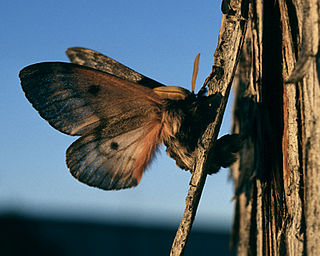
Coloradia is a genus of moths of the family Saturniidae. There are nine described species found in Mexico and eastern North America. The genus was first described by C. A. Blake in 1863.
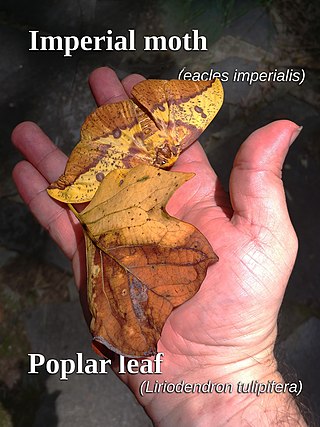
Eacles is a genus of moths in the family Saturniidae. They are native to the Americas. The genus was erected by Jacob Hübner in 1819.
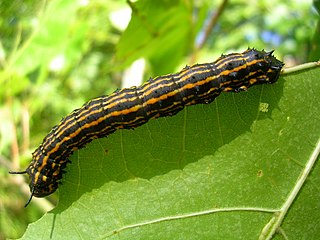
Anisota senatoria, the orangestriped oakworm, also known as the orange-tipped oakworm, is a Nearctic moth of the family Saturniidae and subfamily Ceratocampinae. It is one of the more common Saturniids, reaching pest status occasionally in the northern parts of its range. As they are late-season feeders, however, they do little lasting damage to their hosts. It is very similar to A. finlaysoni in southern Ontario and A. peigleri in the southern US. The species was first described by James Edward Smith in 1797.

Saturnia is a genus of large silkmoths in the family Saturniidae, which the German biologist Franz von Paula Schrank first described in 1802. Its members are commonly named emperor moths, though this is also used for various close relatives in subfamily Saturniinae. Most species are Palearctic, but three, commonly called "saturnia moths", inhabit the chaparral of California: S. mendocino, S. walterorum, and S. albofasciata.

The dryandra moth is a species of moth that is considered to be the sole member of the family Carthaeidae. Its closest relatives are the Saturniidae and it bears a resemblance to many species of that family, bearing prominent eyespots on all wings. The common name is derived from the Dryandra shrubs of the genus Banksia, on which the larva of this species feed, and is hence restricted to the south-west of Western Australia where these shrubs grow. Other Grevillea shrubs may also be used as host plants.

Caligula is a genus of moths of the family Saturniidae. It is primarily an Oriental genus, found in India, China and Southeast Asia. The genus is often treated as a synonym of Rinaca. It is named after Roman emperor Caligula.

The Saturniinae or saturniines are a subfamily of the family Saturniidae, also known as giant silkmoths. They are commonly known as emperor moths or wild silk moths. They are easily spotted by the eyespots on the upper surface of their wings. Some exhibit realistic eye-like markings, whilst others have adapted the eyespots to form crescent moon or angular shapes or have lost their wing scales to create transparent windows. They are medium to very large moths, with adult wingspans ranging from 7.5 to 15 cm, in some cases even more. They consist of some of the largest sized Lepidoptera, such as the luna moth, atlas moth, and many more. The Saturniinae is an important source of wild silk and human food in many different cultures.

Eupackardia is a monotypic moth genus in the family Saturniidae erected by Theodore Dru Alison Cockerell in 1912. Its only species, Eupackardia calleta, the calleta silkmoth, was described by John O. Westwood in 1853. It is found in Mexico, Guatemala, as well as in the states such as; Arizona, New Mexico, and Texas.
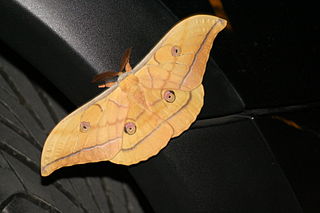
Antheraea yamamai, the Japanese silk moth or Japanese oak silkmoth is a moth of the family Saturniidae. It is endemic to east Asia, but has been imported to Europe for tussar silk production and is now found in southeastern Europe, mainly in Austria, northeastern Italy, and the Balkans. It seems to be spreading north and a population has been reported near Deggendorf and Passau in Germany. The species was first described by Félix Édouard Guérin-Méneville in 1861. It has been hybridized artificially with Antheraea polyphemus of North America.
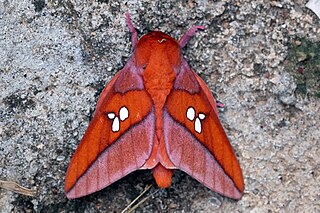
Ceratocampinae is a subfamily of moths in the family Saturniidae. Species can be found in the New World.
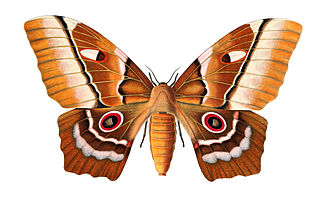
Pseudimbrasia is a monotypic moth genus in the family Saturniidae described by Pierre Claude Rougeot in 1962. Its only species, Pseudimbrasia deyrollei, described by James Thomson in 1858, is found in the mid-latitudes of Africa.

Antheraea pernyi, the Chinese oak tussar moth, Chinese tasar moth or temperate tussar moth, is a large moth in the family Saturniidae. The species was first described by Félix Édouard Guérin-Méneville in 1855. Antheraea roylei is an extremely close relative, and the present species might actually have evolved from ancestral A. roylei by chromosome rearrangement.

Automeris is a genus of moths in the family Saturniidae and the subfamily Hemileucinae. As of 1996 there were 124 species, and more have since been described. These moths are generally characterized by the eyelike patches on the hindwings and the leaflike pattern on the forewings, an example of crypsis. The genus was first described by Jacob Hübner in 1819 and it is distributed in the Neotropical realm.

Samia is a genus of moths in the family Saturniidae. The genus was erected by Jacob Hübner in 1819.

Cricula is a genus of moths in the family Saturniidae first described by Francis Walker in 1855.
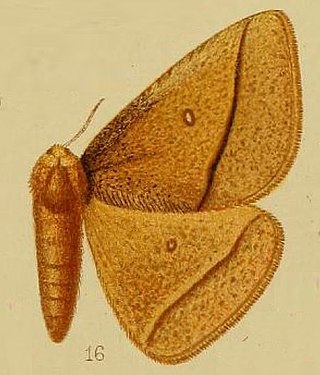
Decachorda is a genus of moths in the family Saturniidae. The genus was erected by Per Olof Christopher Aurivillius in 1898.
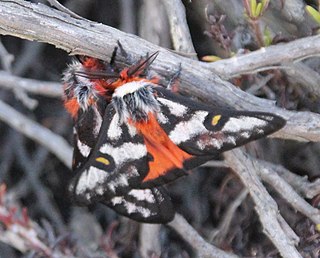
Hemileuca electra, the electra buckmoth, is a species of buck or io moth in the family Saturniidae. It is found in Central America and North America.
Antheraea roylei is a large moth in the family Saturniidae occurring in Nepal, Thailand, Burma, Vietnam, West Malaysia, and the Himalayan regions of India. The species is considered to be the wild progenitor of the domesticated species known as Antheraea pernyi; the theory is that pernyi may have evolved from ancestral A. roylei by chromosome rearrangement during domestication.


















